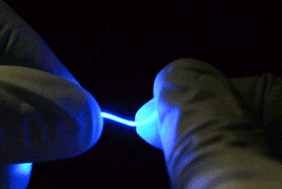Optogenetics, the technology and science looking at interaction with neurones and nerves, is a new area but it has already achieved in a short time amazing results in looking at brain neuronal circuits expanding our understanding of its structure and functions. Microscopic probes have been created to minimise damage to the brain. Each probe should be able to carry light (an optical fibre of sort) and electrical signals, both harvesting the ones generated by neurones and the ones used to stimulate them.
Connecting probes with nerves in the spinal corde is, technically speaking, more challenging since these move as the person moves. Hence the probe needs to be pliable and soft to avoid damaging the nerves as they move.
This is what has been addressed by a team of researchers based at MIT.
They have created a flexible and stretchable probe using nanowires and an elastomer. The latter is used to carry light the former are wrapped around it and carry electrical signals.
The probe is so flexible that can be used for sutures and it can stretch up to 30% of its length without losing its functionality.
They have tested their properties and their resistance to continuous stress by implanting them in the spinal cord of mice. Equally important they have proved that their implantation does not damage the nerves in the spinal cord even in a prolonged use.
The hope is that this technology can boost progress in restoring nerve pathways helping people with traumatic paralyses.







